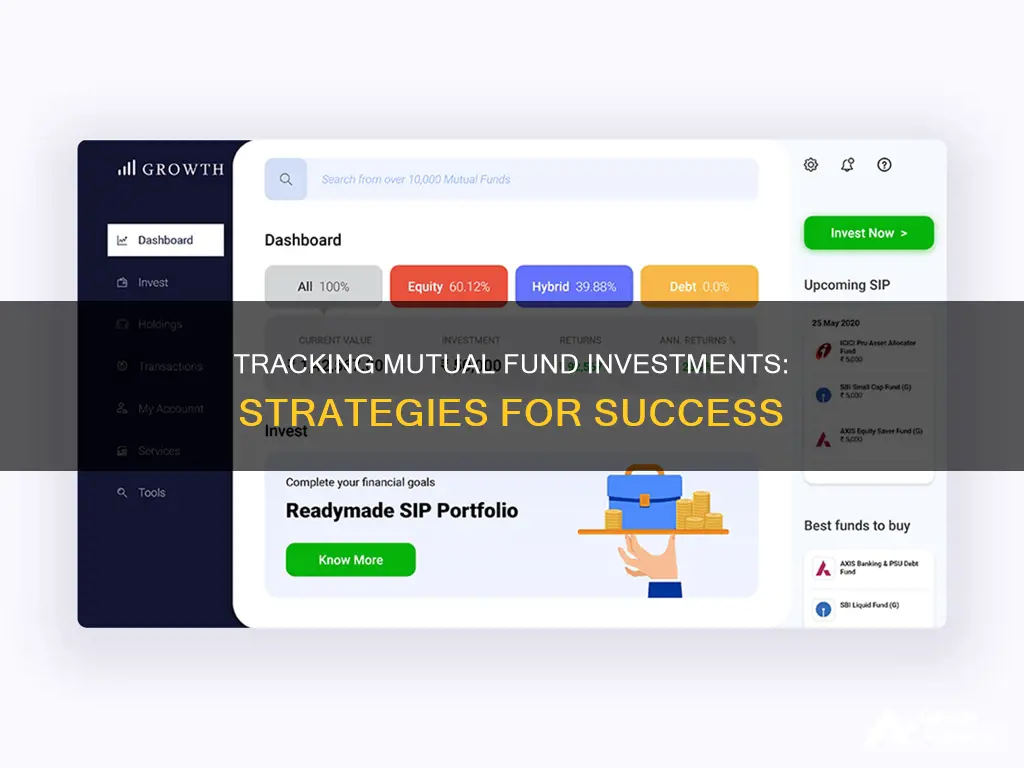
Keeping track of your mutual fund investments is essential to ensure everything is on track and working as expected. There are several ways to monitor the performance of your mutual fund investments, including:
- Consolidated Account Statements (CAS)
- AMC websites or mobile apps
- Online portfolio trackers
- Mutual fund fact sheets
- Consulting a financial advisor
| Characteristics | Values |
|---|---|
| Frequency of review | Periodically |
| Sources of information | Financial advisor, online portfolio trackers, apps, websites, fact sheets, account statements, news |
| Comparison | Compare fund performance against benchmarks and other similar funds |
| Analysis | Analyse portfolio performance, fees and expenses, and investment goals |
What You'll Learn

Use a financial advisor
Using a financial advisor is a great way to keep track of your mutual fund investments. A financial advisor is a licensed professional who can help you navigate the often confusing world of investing. They can offer guidance and support, and ensure you are on track to meet your financial goals.
A good advisor will take the time to understand your current financial situation and your investment objectives. They will then be able to advise you on the best mutual funds to invest in, creating a portfolio that is tailored to your needs. This is especially useful if you are new to investing or don't have the time to manage your investments yourself.
Financial advisors have a fiduciary duty to act in your best interests. They should disclose all aspects of an investment to you, in a clear and ethical manner. A good advisor will also keep you informed about the performance of your investments and make suggestions for any necessary changes.
When choosing a financial advisor, it is important to select someone experienced and qualified. Look for someone who has seen various market fluctuations and can demonstrate a comprehensive financial methodology. They should also be proactive in managing your portfolio, keeping on top of market trends and news, and making adjustments as necessary.
Your advisor should also be able to explain things to you in a way that is easy to understand. They can help you interpret the fact sheets and Scheme Information Documents (SIDs) provided by mutual funds, so you can feel confident about your investments.
Remember, it is still a good idea to have a basic understanding of your investments, even if you are working with an advisor. This will help you make informed decisions and ensure you are comfortable with the strategies being employed.
Unlocking Opportunities: Investing in VC Funds
You may want to see also

Compare to other funds
When comparing mutual funds to other types of funds, there are several key factors to consider. Here are some important aspects to help you make informed decisions:
Performance and Returns
One of the essential considerations when comparing mutual funds to other funds is their performance and returns. It is advisable to evaluate the long-term performance of mutual funds, considering 5-, 7-, or even 10-year returns. This is because, while short-term returns may fluctuate, mutual funds are designed for long-term growth. Additionally, it is crucial to assess the consistency of returns, as this indicates the fund's ability to deliver stable performance over time.
Risk Factors
When comparing mutual funds to other funds, it is vital to analyse the risk factors involved. There are several risk measurement ratios to consider, including:
- Standard Deviation: This measures the volatility of the fund, indicating how much the returns deviate from the average.
- Sharpe Ratio: This ratio evaluates the risk-adjusted returns, showing the extra returns generated for the additional risk taken.
- Sortino Ratio: A modification of the Sharpe Ratio, it uses downside deviation to determine the downside volatility risk.
- Alpha: Alpha indicates the mutual fund's ability to generate higher returns than its benchmark index.
- Beta: Beta shows the extra risk taken by the mutual fund to achieve returns higher than its benchmark.
Expense Ratio
The expense ratio is an important factor to consider when comparing mutual funds to other funds. It represents the annual percentage charged by the fund house for managing your money. While there may be a ceiling set by regulatory bodies, such as SEBI, on the upper limit, it is crucial to understand the impact of the expense ratio on your returns.
Portfolio Level Information
When comparing mutual funds to other funds, it is essential to analyse the portfolio level information. This includes understanding the allocation across market caps (Large Cap, Mid Cap, and Small Cap) and the number of securities held by the fund. Additionally, for debt investments, the average maturity and modified duration are crucial factors, as they help determine the interest rate sensitivity of the scheme.
Benchmark Comparison
When comparing mutual funds to other funds, it is important to evaluate their performance against the relevant benchmark. All mutual funds are benchmarked to a specific index, and you can assess how the fund has performed relative to that index. This provides context to the fund's returns and helps you understand if it is meeting or exceeding expectations.
In summary, comparing mutual funds to other types of funds requires a comprehensive analysis of various factors, including performance, returns, risk, expenses, and portfolio details. By considering these aspects, you can make more informed decisions and select funds that align with your investment goals and risk tolerance.
A Smart Guide to Nifty 50 Index Fund Investment
You may want to see also

Review account statements
Reviewing your account statements is a crucial step in keeping track of your mutual fund investments. These statements provide a comprehensive summary of your investments and help you understand their performance. Here are some key points to keep in mind when reviewing your mutual fund account statements:
- Personal Information: Verify that your personal details, such as your name, address, PAN (Permanent Account Number), email, and contact number, are accurate and up to date. Any discrepancies should be reported to the mutual fund company or Asset Management Company (AMC) immediately.
- Summary of Investments: This section provides an overview of your mutual fund investments, including the scheme name, folio number, units held, Net Asset Value (NAV), and the current value of your investments. Pay close attention to any gains or losses highlighted in this section, as they indicate the performance of your investments.
- Transaction History: Carefully review the transaction history section, which records all transactions related to your mutual fund investments, such as purchases, redemptions, and switches. Check the transaction details, including dates, types of transactions, units bought or sold, NAV, and transaction amounts, to ensure accuracy and consistency with your investment activity.
- Dividend History: If you have invested in dividend-paying mutual funds, review this section to cross-check the dividend payout dates, NAV on payout dates, and dividend amounts with your records.
- Tax Information: Understand the tax implications of your mutual fund investments by paying close attention to this section. It includes information on capital gains, dividend distribution tax, and other tax-related details. Consult a tax advisor if needed to ensure accurate tax reporting.
- Contact Information: Note down the contact details of the mutual fund company or AMC provided in the statement. This information will be useful if you have any queries or need assistance regarding your investments.
- Glossary of Terms: Some statements may include a glossary of terms to help you understand the jargon and terminologies used. Refer to this section if you come across any unfamiliar concepts or acronyms.
- Load Structure: Understand the entry and exit costs associated with your investment by reviewing the load structure information in the statement. Note that the exit load applicable upon redemption is the one prevailing at the time of investment, not the current structure of the fund.
Remember to review your account statements regularly to ensure you are meeting your financial goals, verify transaction accuracy, report taxes correctly, and protect your investments. If you notice any discrepancies, promptly bring them to the attention of the mutual fund company or AMC.
Funding Your Capital One Investing Account: A Guide
You may want to see also

Consult an advisor
Consulting a financial advisor is a great option if you're feeling overwhelmed by the prospect of tracking your mutual fund investments, or if you simply prefer to have a professional guide you. Here's how a financial advisor can help:
Professional Expertise
Financial advisors are industry experts who stay up-to-date on market trends, economic conditions, and regulatory changes that could impact your investments. They can help you navigate the complexities of the mutual fund landscape and make informed decisions.
Individualized Advice
A financial advisor will assess your unique financial goals, risk tolerance, and investment objectives to provide tailored advice. They can help you select mutual funds that align with your goals and make adjustments as your circumstances or the market environment change.
Portfolio Analysis
Financial advisors have the tools and resources to thoroughly analyse the risk and return profile of your mutual fund investments. They can identify any areas for improvement, such as diversification, asset allocation, or fund selection, to optimise your portfolio.
Monitoring and Rebalancing
Financial advisors can monitor your mutual fund investments on an ongoing basis and provide timely recommendations for rebalancing your portfolio as needed. This proactive approach ensures your investments remain aligned with your goals and risk tolerance.
Behavioural Guidance
Investing can be an emotional journey, especially during market downturns or volatile periods. A financial advisor can provide behavioural guidance to help you stay disciplined and avoid making impulsive decisions based on short-term market fluctuations. They can keep you focused on your long-term investment strategy.
Educational Resources
Financial advisors can educate you about mutual funds, investment strategies, and market concepts in simple, easy-to-understand language. This empowers you to make more informed decisions and actively participate in tracking your investments.
Regulatory Compliance
Financial advisors are well-versed in the regulatory requirements and guidelines associated with mutual fund investments. They can ensure your portfolio complies with legal and tax regulations, helping you avoid potential pitfalls and penalties.
When choosing a financial advisor, it's important to select a qualified, SEBI-registered advisor who acts in your best interest. They can be a valuable partner in your financial journey, offering sound advice and helping you make the most of your mutual fund investments.
A Guide to Investing in India's Thriving Funds Market
You may want to see also

Use online portfolio trackers
Online portfolio trackers are a great way to monitor your mutual fund investments. These tools can help you stay on top of your investment portfolio, providing real-time information and analysis to help you make informed decisions.
Features of Online Portfolio Trackers
Portfolio trackers offer a range of features to help you manage your investments effectively. Here are some key features to look out for:
- Real-time data and monitoring: Portfolio trackers provide up-to-the-minute information on your investments, allowing you to know where you stand and make data-driven decisions.
- Syncing with financial accounts: Most portfolio trackers can sync with your existing financial accounts, such as investment and banking accounts, making it easy to access and analyse all your financial data in one place.
- Retirement planning: Some trackers include retirement planning tools that can help you set savings goals and create a spending plan to achieve them.
- Asset allocation: Trackers enable you to monitor your portfolio's diversification and compare it to benchmark indices. This helps you ensure your portfolio aligns with your risk tolerance and financial goals.
- Performance analysis: You can track the performance of your investments over time, analyse returns, and compare them against various benchmarks.
- Dividend tracking: Portfolio trackers can help monitor dividend income and distributions, as well as calculate dividend yield.
- Tax reporting: Some trackers offer tax reporting features, making it easier to prepare and file your tax returns, especially when dealing with multiple investments.
Examples of Online Portfolio Trackers
- Empower (formerly Personal Capital): This platform offers a comprehensive view of your financial picture, including investments, bank accounts, credit cards, and more. Empower provides features such as investment check-up, retirement planning, and budgeting.
- SigFig Wealth Management: SigFig offers a free version that tracks investment accounts in real-time and provides weekly summaries. The fee-based version allows for a personalized plan based on risk tolerance and time horizon.
- Sharesight: Sharesight is ideal for international investors, offering coverage of global stocks, ETFs, funds, and currencies. It provides performance tracking, dividend tracking, and tax reporting features.
- Equitymaster's Portfolio Tracker: This tracker provides intelligent tools and reports to analyse your portfolio and track its movements even during trading hours. It offers features like email alerts, mobile accessibility, and value-added reports.
Benefits of Using Online Portfolio Trackers
Online portfolio trackers offer several advantages:
- Convenience and accessibility: You can access your portfolio information anytime, anywhere, through user-friendly dashboards and mobile apps.
- Consolidated view of investments: Trackers provide a consolidated view of your investments, helping you stay organised and make informed decisions based on a holistic understanding of your financial picture.
- Time-saving: With automated data syncing and analysis, portfolio trackers save you time and effort in manually tracking and analysing multiple investments.
- Data-driven decision-making: By providing real-time data, performance analysis, and benchmarking, portfolio trackers empower you to make more informed and strategic investment decisions.
- Risk management: By monitoring your portfolio's risk level and providing tools for rebalancing, trackers help you manage and mitigate investment risks effectively.
Corporate Money: Investing in Vanguard Index Funds
You may want to see also
Frequently asked questions
A mutual fund is an investment that pools money from many investors and invests it in a mix of schemes.
There are several ways to keep track of your mutual fund investments, including Consolidated Account Statements (CAS), AMC websites or mobile apps, online portfolio trackers, and Mutual Fund Fact Sheets.
A CAS is a monthly statement that provides a consolidated view and valuation of all your mutual fund investments. It is issued by CDSL or NSDL for months when there has been a financial transaction in your mutual fund portfolio.
Mutual Fund Fact Sheets are monthly documents released by AMCs, providing detailed information about their mutual fund schemes, including portfolio allocation, NAV, fund managers, and investment performance.
It is recommended to review your mutual fund portfolio at regular intervals to ensure it aligns with your risk appetite and financial goals. While you should avoid making adjustments at short intervals, regular tracking helps ensure everything is on track.







